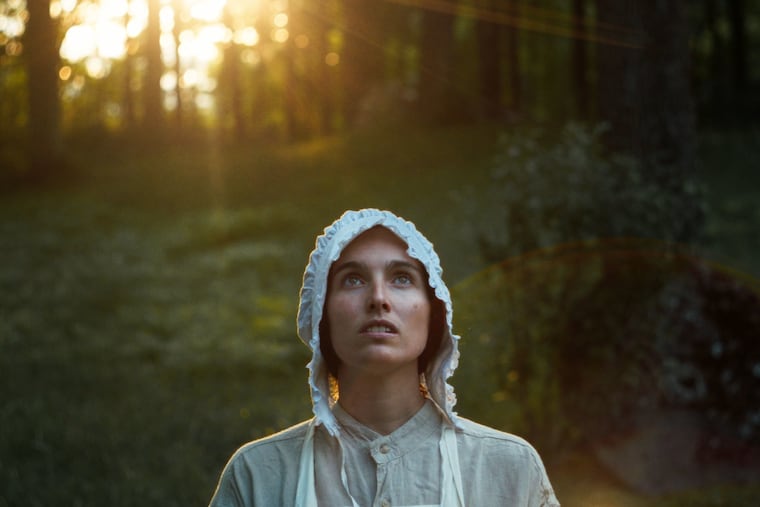Queer artists reimagine the story of a 19th-century doomsday movement
In 'Those Who Wait,' the origin story of the Seventh Day Adventist Church unexpectedly reflects a queer yearning for a better world.

Two decades before the American Civil War, a doomsday prophecy spread across rural communities in the Northeast.
A farmer in Upstate New York named William Miller claimed he had divined from the Bible that the world would end between 1843 and 1844. For thousands of people concerned with the state of the world, many of them abolitionists, the idea was seductive. That end did not come for the so-called Millerites — it was dubbed “The Great Disappointment” — but their movement was the precursor to the Seventh-day Adventist Church, a conservative, evangelical Christian denomination that believes the end is still near.
These historical events serve as the inspiration for Those Who Wait, an experimental film that will screen on Sept. 4 at the Philadelphia Film Society Center.
You wouldn’t expect a pair of queer filmmakers and their West Philly community to make a film that reenacts the origin story of a church that condemns same-sex relationships.
But for filmmakers Chani Bockwinkel and Ty Burdenski, the Seventh-day Adventist creation story was fertile ground for thinking through some of the pressing questions of our time: What do you do when you’re plagued with a desperate dissatisfaction with the world? How do you live when it seems the only path forward is utter and totalizing change? And what happens when these ideas go too far?
Bockwinkel and Burdenski, both 35 and frequent collaborators who met in the Bay Area in their 20s, started working on the film — their first feature — more than seven years ago. Bockwinkel, who lives in the East Bay, was thinking about the similarities between theorists and religious leaders. Queer theorist Judith Butler, for example, developed frameworks for how entire communities live their lives, she said. How is that different from a prophet?
It was Burdenski’s idea to look more closely at the story of Ellen White, the Millerite religious leader who helped form the Seventh-day Adventist Church. Burdenski, who lives in East Lansdowne, grew up hearing these stories from a Seventh-day Adventist family that cared for them and briefly attended a Seventh-day Adventist school.
The film — featuring a cast of West Philly queers donning top hats and bonnets — loosely traces the stories of Miller and White, as well as William Foy, a Black minister and Millerite prophet, and White’s twin sister, Elizabeth Harmon, the only person in her family who did not believe the apocalyptic message.
Bockwinkel and Burdenski take liberties reimagining Harmon and Foy’s stories, as Harmon barely figures in traditional retellings of Seventh-day Adventist history and Foy’s story, Burdenski said, was rewritten to serve the Adventist narrative.
Trey Shields, director of year-round programming at the Philadelphia Film Society, said he chose the film for PFS’s local film showcase because of how it approached a historical moment in “a creative, compelling, and fantastical way that was equally enchanting in its ... queer lens and gorgeous cinematography.”
Those Who Wait is neither a documentary nor a narrative film (its inability to be classified is an aspect of its queerness, Bockwinkel says). It leans heavily on sound, movement, and slow shots, dwelling on images of people smelling flowers and gazing at the sunrise after expecting the world to end, and it leans very lightly on dialogue.
As an early title card explains: “We look to the Hopeful — these ‘Millerites’ — not as a history lesson but as experts in a feeling.”
For Burdenski, every creative project is “a cipher,” a lens for seeing the world. And this one was uncanny. There were countless examples of that apocalyptic feeling — the exhilaration that things just might change — during the pandemic and the Black Lives Matter protests. And then, there was the disappointment, when transformative change did not come to pass, mirroring the cycles of Millerite hope and disappointment depicted in the film.
“We unexpectedly came into empathy” with the Millerites while working on the project, Burdenski said. The result is a film that neither satirizes the believers nor glorifies them. “We kept flip-flopping on who they were, Bockwinkel says. “Were they heroes or fools?” Ultimately, they play both roles, the filmmakers said.
The film does not have the standard trappings of what’s understood as LGBTQ: There is no sexuality or romance in the film. Instead, the project’s queerness is a sensibility that seeps in, the filmmakers say: There is the attempt to reimagine a creation myth, the act of projecting queer West Philly into a repressed world, and what feels quintessentially queer: a yearning for a better world.
”Those Who Wait” screens on Sept. 4 at 7:30 p.m. at the Philadelphia Film Society Center, 1412 Chestnut St., Phila., https://filmadelphia.org/movies/those-who-wait/